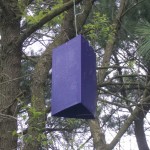Photos of the EAB traps are available for media use on Flickr.
Photos of the Emerald Ash Borer are available for media use from the USDA’s Animal and Plant Health Inspection Service.
DOVER – Hanging purple beetle eaters?
No, they’re not lyrics from a 1958 novelty song, but instead are vital tools in Delaware’s fight to protect the First State’s trees from a dangerous forest pest.
Delaware Department of Agriculture staff members are placing triangular purple traps in trees across Delaware in 54 locations, in all three counties, designed to detect whether a tree-killing insect has made its way into Delaware.
The traps, which contain a nontoxic chemical lure, will attract an insect known as the Emerald Ash Borer, if it’s nearby. The Emerald Ash Borer can devastate ash trees, which make up one percent of Delaware’s forests. Green ash trees are common in southern Delaware along stream banks, and white ash is often found in northern Delaware’s upland forests and as a street tree in some neighborhoods.
“It kills ash trees within just a few years by burrowing under the ash tree’s bark and starving the tree to death,” said Jim Kroon, Delaware’s pest survey coordinator for the Department of Agriculture’s Plant Industries Section. “We hope the Emerald Ash Borer stays out of Delaware, but need to monitor for it to make sure that’s the case.”
The Department of Agriculture has set the traps every year since 2008, with most traps set near highways and in municipal areas. While the traps have so far thankfully come up empty, EAB has been found within an hour’s drive of state lines in Maryland and Pennsylvania. EAB can spread naturally at a rate of three miles a year, but it is often carried in firewood and commercial products containing ash.
“We don’t want this pest to hitch a ride into Delaware. To help prevent the spread, campers and visitors should buy only local firewood or firewood with a U.S. Department of Agriculture treatment stamp,” said Dr. Faith Kuehn, Plant Industries manager.
The combination of the chemical lure and bright purple color in the traps has been found to attract the insects, Kroon said. The traps will be placed in ash trees 10 to 20 feet off the ground. Most traps will be hung along roads and public right-of-ways, and on private property with permission of the landowner. They pose no risk to humans or pets, but the glue coating the trap is extremely sticky and messy if touched.
Residents who have questions about Emerald Ash Borer, think their trees may be infested or see a fallen trap should contact Kroon at 302-698-4586.
# # #
Contact:
Dan Shortridge
Chief of Community Relations
Delaware Department of Agriculture
302-698-4520